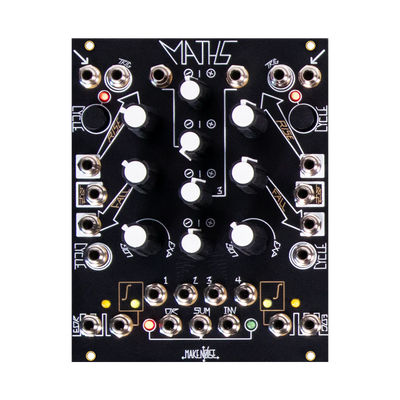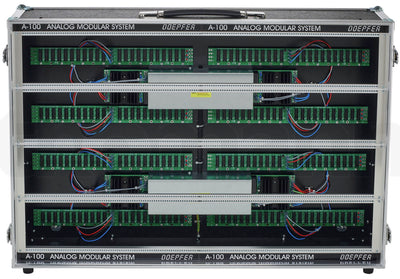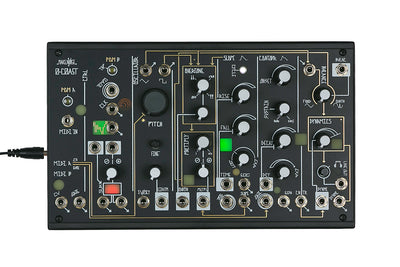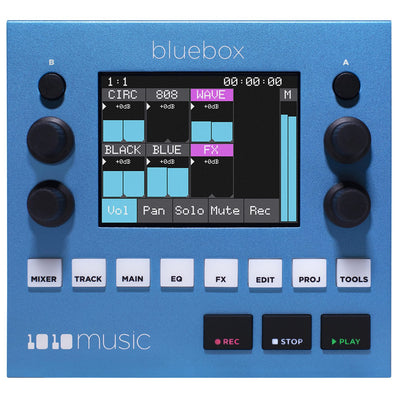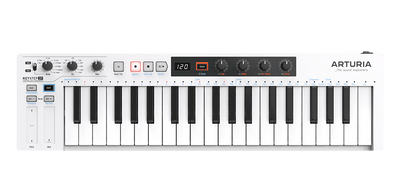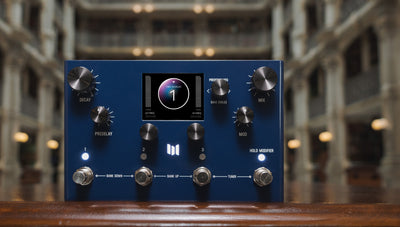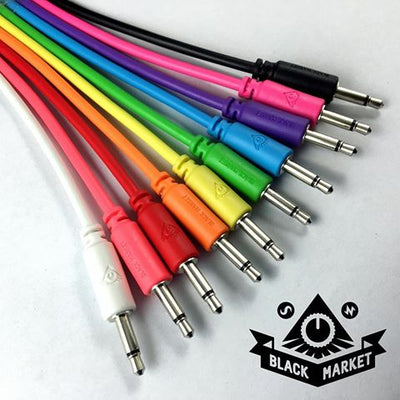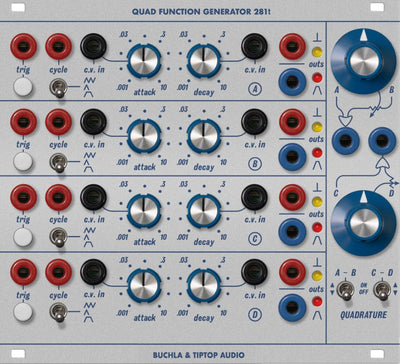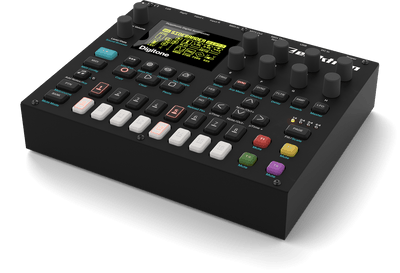All Controls—arranged in order of signal flow—and Patch Points
VCO:
RANGE – Oscillator frequency attenuator.
PW MAN – Variable pulse wave width control.
OCT – +1/-1 octave switch.
LFO (^) – Triangle wave low frequency oscillation to pulse width control.
FREQ/PW – Oscillator frequency, or Pulse (square wave) width to ADSR modulation routing switch. Center off.
PORTA – Slew generator control.
MOD (ENV) – Oscillation modulation via ADSR control.
TRIANGLE*
/NO VCF – Triangle to VCA switch—bypasses VCF.
SAWTOOTH* – Sawtooth wave attenuator.
SQUARE* – Square wave attenuator.
SUB – Square wave Sub Oscillator attenuator.
TRIANGLE* – Waveform output.
SAWTOOTH* – Waveform output.
SQUARE* – Waveform output.
MIX – Composite waveform output.
1V/O – One volt per octave control voltage input.
TUNE – Master fine tune (approx. -5/+ 5 semitones).
MOD IN – Modulation CV input. Normaled to ADSR; ADSR is replaced when alt. source connected.
* symbol
Noise:
NOISE – White noise generator output.
LEVEL – Noise attenuator.
VCF:
FREQ - Frequency, or cut-off attenuator.
RESO – Resonance, or Q attenuator.
KYBD – Keyboard/voltage tracking attenuator.
DRIVE – Oscillator output to filter input attenuator.
HPF – High Pass Filter.
ENV – Filter to ADSR envelope attenuator.
MOD (LFO) – Filter to LFO attenuator.
EXT IN – External audio input.
FIL OUT – Filter audio output.
MOD IN – Frequency or Resonance modulation CV input.
LFO:
TRIANGLE/SQUARE* – Waveform select switch (triangle core).
AMNT (OSC) – LFO to Oscillator control.
RATE – Speed or rate attenuator.
AMNT – Control voltage Input.
TRIANGLE* – Triangle wave output.
SQUARE*– Square wave output.
RATE – Speed or rate CV input.
* symbol
ENVs:
A – Attack stage control.
D – Decay stage control.
S – Sustain stage control.
R – Release stage control.
HOLD/MSTR – Indefinite/instant sustain; master mode switch for single ADSR: fuses VCF envelope with VCA envelope. Center off.
A – VCA Attack stage control
R – VCA Release stage control.
MOD IN – Allows for dynamic modulation of the ADSR, eg., if you want the amount of modulation added to/determined by a external source, jack in; or if you prefer, modulation input to the ADSR routing—use with velocity, or a sequencer: the sequencer could isolate the ADSR amount the amount to a single step in the phrase for example. Exciting. A second external envelope can provide an interesting effect, or the AR (in the box patching).
ADSR OUT – ADSR output.
AR OUT – AR Output.
VCA:
FEEDBACK – Oscillator/filter feedback loop control.
VOLUME – Master volume control.
VCA CV – Amplifier control voltage output.
IN/MIX – VCA mix input switch switch (normalled jack). When set to IN, external audio replaces filter output to VCA; when set to mix MIX, filter output is fed along with the filter audio to VCA.
VCA IN – Audio input.
OUTPUT – Main output.
Vitals
PCB Mounting Scheme - Through-hole.
Filter - A 6db/oct hi-pass filter followed by a recreation of the Roland® IR3109 module, which is a 4 pole, 24 db/oct voltage controlled lowpass filter with voltage controlled resonance. 3 dual OTAs with similar topology to the BA662 used in the Jupiter 8 (and the IR3109 module) were employed, 1 amp for the hi-pass filter, 4 (with added buffers) for the low-pass, and 1 for the resonance. This filter takes a wide range of input signals, and tracks control voltage extremely well. Tap points are available for 6db, 12db, and 18db/oct. Although the topology is similar to the 4072, the tonality, especially when over driven, is distinct
.
Size - 32hp.
Depth - 35mm including connectors.
Power Usage - 130mA, 80mA (+12 / -12)
PDF Redux
Outs to Outs and Other Interesting TONE☆ Patches



